That of Young Art Hunters is a reality, born a few years ago, with the aim of carving out a space within Milan that is to all intents and purposes of art and for art. The very young founders Barbara Basile (curator of exhibitions and coordinator of artists) and Elia Panori (art director), together with collaborator Enrico Pescarolo (contact person for the international part) tell us about it.
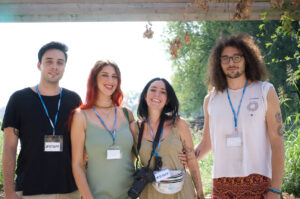
From the left: Enrico Pescarolo, Lorenza Pagliari, Barbara Ludovina Basile, Elia Panori. Foto di Niccolò Misrachi, courtesy The YAH Factory, Milano
Anna Setola: What you created is a very young environment. When was Young Art Hunters born and what intentions did you have?
Barbara Basile: The project was born from me and Elia Panori in 2019, when we realized that there are very few realities related to emerging art in Milan. We started as a simple art organization, we didn’t have a space, we were traveling a bit nomadically looking for realities that would be interested in hosting an exhibition. In the long run, however, this constant wandering became a bit complicated, we always had to depend on someone else. So we felt the need to find a physical space and in 2022 we opened the gallery.
At the beginning of your journey with Young Art Hunters you had to face the complex times of emergency due to Covid 19. What did you do to continue your work in such an uncomfortable situation?
Elia Panori: It was not easy, at that time, we had started just under a year earlier and all the proposals, all the potential seemed to have been lost. We wondered whether to go on or give up but we decided to reinvent ourselves. Since we could no longer do physical exhibitions I learned to work in 3D to create virtual rooms. They were successful and were instrumental at that time in continuing to make art travel and share it.
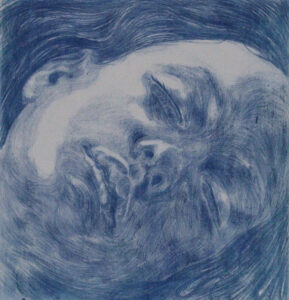
Mauro Valsecchi, “I sognanti vivono con gli occhi chiusi”, 2021, pigmento su carta, 37 x 37 cm. Foto di Elia Panori, courtesy of the artist
The name you have given to your space is The YAH Factory. What significance does this concept of “factory” have for you and how do you interpret it?
Elia Panori: We named the space The YAH Factory inspired by Andy Warhol. We noticed how in Milan the gallery context is always too private and elitist. We wanted to make it more inclusive and therefore, let’s say, play with transforming the very concept of the gallery. Our intention is not to occupy a space simply to display artworks, rather to create a place of meeting, of exchange, where we can come and discuss and create. Once a month we do what we have called the “open factory”, basically we open the gallery to all enthusiasts, artists, and collectors to build a moment of dialogue. A reference theme is chosen and many people, painters, but also poets, come here just to create together. It is a situation that precisely fabricates ideas because it generates contacts, friendships, projects: a sharing without stakes of art and of the contemporary, above all.
Barbara Basile: we wanted to recreate that atmosphere of the ateliers and cafes from the early 20th century, where the avant-garde was formed, but do it in a contemporary way. Dealing with a lot of young people we realize that probably many of them don’t even have the space to create so we provide it. I think it’s fundamental to build a network where people can get to know each other and collaborate.
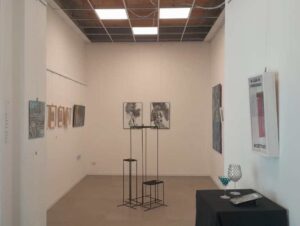
“Sio 2”, exhibition view, 2024, galleria The YAH Factory, Milano. Foto di Elia Panori, courtesy of the artists
What does it mean to you to give space to emerging artists?
Elia Panori: Emerging artists have so much to say and, most importantly, they have no limits. We are interested in the fact that they don’t have as much experience because it is through exhibitions, and people’s feedback, that you build your career. Emerging artists through their flaws, their mistakes, have a type of expressing themselves that more highly rated artists, with their own established style, do not have.
Barbara Basile: We have the opportunity to take care of them from their beginnings, we see artists start with one technique and work their way up to another. It is an important opportunity to be able to learn about their creative process. Art first and foremost is sharing, you can learn so much from others.
Within your gallery you try to build a heterogeneous and composite landscape, proposing artists from the most diverse practices and poetics. With what intentions do you formulate your selection of works and artists?
Elia Panori: We like to range and create heterogeneity. At first it was a bit difficult because despite the quality, the presence of so many different techniques in the exhibition was often not understood. But then it slowly worked and inclusiveness became the hallmark of the gallery. Clearly in the selection there is a part of personal taste, which comes from our cultural background and artistic path.
Barbara Basile: There is a lot of research for every exhibition we do, months of research. The gallery obviously has its own identity, so we also have to find those artists who can best represent it.
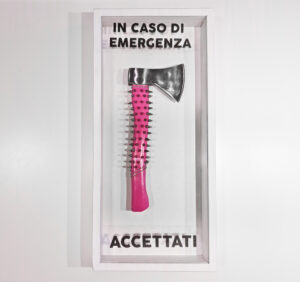
Acrylic Needs, “Accettati”, 2021, legno, borchie e plexyglas, 65 x 30 cm. Foto di Elia Panori, courtesy of the artist
Milan is definitely a nerve center for culture and art in Italy, but it can also be easy to stumble upon its abundance. As a gallery and as an association, what is your relationship with this city?
Elia Panori: Milan is a city that I love and hate; I love it because it has given me potential, it has given me input for which I thank it. But then comparing it to other countries I realize that we are behind on other things. It is a city whose energy needs to be channeled into cultural projects, there are so many associations, so many foundations, but we need even more.
Barbara Basile: In Milan it is very difficult for a reality like ours to emerge. We opened the association hoping to get some grants from the municipality, some patronage, some help, and instead we have always found ourselves alone in this. We continue because there is a desire to do something, to really change the rules of the game, however it is difficult anyway.
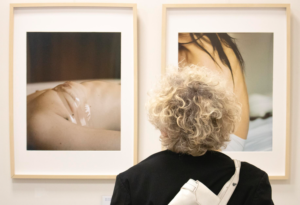
“Blooming Blood”, exhibition view, 2023, galleria The YAH Factory, Milano. Foto di Elia Panori, courtesy of the artist
What are your upcoming planned projects?
Enrico Pescarolo: Our dream is to open a branch abroad. At the moment we do several exchanges with foreign galleries to introduce our artists to new realities, but also to introduce our own. We would like to go to Brafa Art Fair in Brussels in February 2025. Let’s say we don’t want to be just an Italian reality, but we try to bring artists from different backgrounds and different countries into our gallery, in fact we have hosted artists from the United States, from India, from Japan. Also, we will soon launch our own portal, so we will also have an entirely online section where artists can be exposed to a very wide audience. It is under development, it will be a portal with related app where artists can sign up and collectors can also sign up to create their own virtual collections and buy the works. As for fairs in Italy, we participated in Mia Photo Fair and we would like to try to go to The Others Art Fair in Turin in November.
Anna Setola
Info:
The YAH Factory, Milano
La nuova galleria per artisti emergenti
youngarthunters.com

is a contemporary art magazine since 1980






NO COMMENT